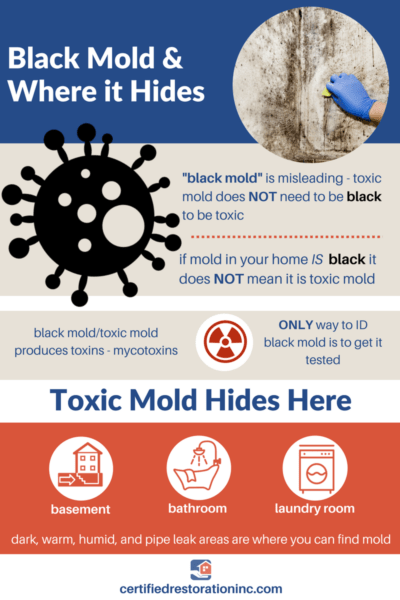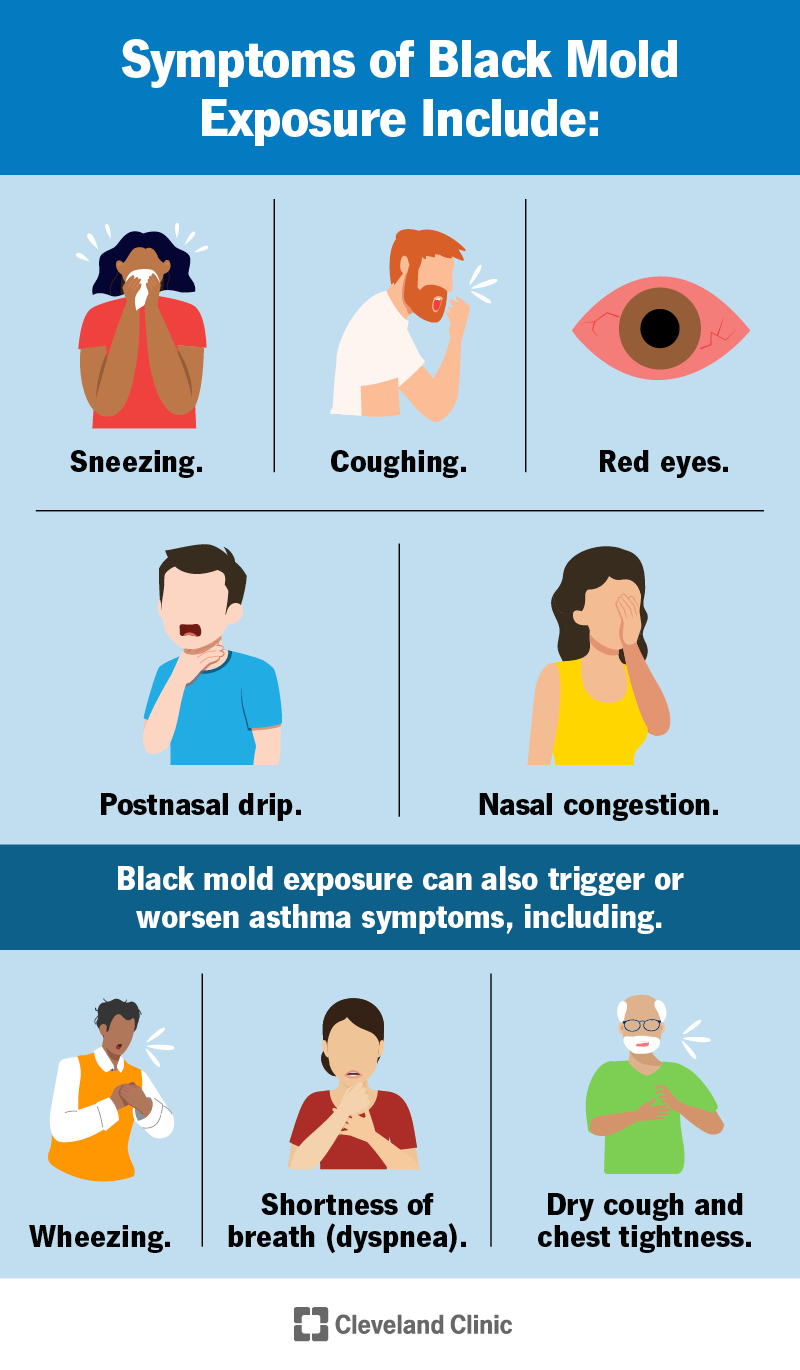In this article, we’ll discuss the physical symptoms that can occur when you are exposed to black mold. We will provide you with a comprehensive guide to understanding the health effects that can arise from this exposure. By the end, you’ll have a better understanding of how black mold can affect your body and what signs to look out for.
What is Black Mold?
Black mold, also known as Stachybotrys chartarum, is a type of fungus that thrives in damp and humid environments. It has a dark greenish-black color and a slimy texture. Black mold is often found in areas with water damage or high humidity levels, such as basements, bathrooms, or areas affected by floods or leaks.
Common types of black mold
While Stachybotrys chartarum is the most well-known type of black mold, there are several other species that can also be harmful to human health. These include Aspergillus, Cladosporium, and Penicillium.
How does black mold grow
Black mold requires moisture to grow and reproduce. It thrives in environments with high humidity levels, typically above 55%. When water damage occurs, such as a leak or flooding, it provides the perfect conditions for black mold to thrive. The mold spores can travel through the air and settle on surfaces, where they can grow and multiply if the conditions are right.
Where can black mold be found
Black mold can be found in a variety of locations, including:
- Basements and crawl spaces: These areas tend to have elevated humidity levels, making them susceptible to black mold growth.
- Bathrooms: The combination of moisture from showers, inadequate ventilation, and organic materials (such as soap scum) create an ideal breeding ground for mold.
- Areas affected by water damage: After a flood or a leak, moisture can get trapped in walls, ceilings, or floors, providing an environment for black mold to grow.
- HVAC systems: If the HVAC system is not properly maintained or if there is water damage, mold can grow in the ductwork or on the cooling coils.
- Damp or humid environments: Any area with high humidity levels, such as kitchens, laundry rooms, or poorly ventilated rooms, can be prone to black mold growth.
Health Effects of Black Mold Exposure
Exposure to black mold can have a variety of negative health effects. These effects can vary depending on the individual’s sensitivity to mold, the duration of exposure, and the amount of mold present.
Respiratory issues
One of the most common health effects of black mold exposure is respiratory issues. Mold spores can irritate the respiratory system, leading to symptoms such as coughing, wheezing, shortness of breath, sore throat, and nasal congestion. Individuals with asthma or other respiratory conditions may experience worsening symptoms when exposed to black mold.
Allergic reactions
Black mold can trigger allergic reactions in some individuals. Symptoms of mold allergies include sneezing, a runny or stuffy nose, red or itchy eyes, skin rashes, and watery eyes. These symptoms are similar to those caused by other allergens, such as pollen or dust mites.
Skin problems
Exposure to black mold can also lead to skin problems. Common skin reactions include rashes, irritation, and itching. These symptoms may arise from direct contact with mold spores or from the release of mycotoxins, toxic substances produced by some species of mold.
Headaches
Frequent headaches and migraines are another potential health effect of exposure to black mold. The exact mechanism behind this symptom is not fully understood, but it is believed that the mycotoxins released by certain molds may trigger headaches in susceptible individuals.
Fatigue
Exposure to black mold can also cause fatigue or constant tiredness. This could be due to the immune system’s response to mold exposure, as well as the potential disruption of sleep quality caused by respiratory symptoms or other health effects.
Respiratory Issues
If you have been exposed to black mold, you may experience various respiratory issues. These can include:
Coughing
Persistent coughing is a common symptom of black mold exposure. The mold spores can irritate the respiratory system, leading to a persistent, dry, or productive cough.
Wheezing
Wheezing is another respiratory symptom that may occur after exposure to black mold. Wheezing is characterized by a whistling or squeaky sound when breathing out, caused by the narrowing of the airways.
Shortness of breath
Shortness of breath, also known as dyspnea, can be a worrisome symptom of black mold exposure. It can range from mild to severe, making it more difficult to breathe or catch your breath.
Sore throat
A sore throat is a common symptom of mold exposure. Mold spores can irritate the throat, causing discomfort, pain, or a scratchy feeling.
Nasal congestion
Nasal congestion or a blocked nose is another respiratory symptom that may occur after exposure to black mold. Mold spores can irritate the nasal passages, causing swelling and congestion.
Allergic Reactions
For some individuals, exposure to black mold can trigger allergic reactions. These allergic reactions may include:
Sneezing
Frequent or persistent sneezing is a common allergic reaction to black mold. Sneezing is the body’s way of clearing the nasal passages of irritants.
Runny or stuffy nose
A runny or stuffy nose is another common allergic reaction to mold exposure. Irritated nasal passages may produce excess mucus, leading to a runny nose or nasal congestion.
Red or itchy eyes
Black mold exposure can cause red or itchy eyes, similar to other environmental allergens. This occurs when mold spores come into contact with the eyes, leading to irritation and inflammation.
Skin rashes
Some individuals may develop skin rashes after exposure to black mold. These rashes can be itchy, red, and inflamed, and may appear in areas that came into direct contact with the mold or mycotoxins.
Watery eyes
Exposure to black mold can also cause watery eyes. This occurs when the eyes produce excess tears as a protective response to the irritants present in the mold spores.

Skin Problems
Exposure to black mold can potentially lead to a variety of skin problems. These problems may include:
Rashes
Skin rashes are a common skin problem associated with black mold exposure. Rashes may appear as red, itchy, and inflamed patches on the skin. These rashes can vary in size and severity and may occur in areas that came into direct contact with the mold or mycotoxins.
Irritation
Skin irritation is another common skin problem that can occur after exposure to black mold. The mold spores can irritate the skin, leading to redness, itchiness, and discomfort.
Itching
Itching is a typical symptom experienced by individuals exposed to black mold. Itchy skin can be bothersome and may be accompanied by redness or a rash.
Headaches
Headaches are a potential health effect of exposure to black mold. These headaches can vary in intensity, duration, and frequency. Some individuals may experience frequent headaches, while others may experience more severe migraines.
Frequent headaches
Frequent headaches are a common symptom among individuals exposed to black mold. These headaches can range from mild discomfort to more persistent and severe pain.
Migraines
Migraines are severe headaches characterized by intense pain, often accompanied by other symptoms such as nausea, vomiting, and sensitivity to light and sound. Some individuals may experience migraines as a result of exposure to black mold.

Fatigue
Fatigue or constant tiredness can be a consequence of exposure to black mold. This fatigue may be a result of the immune system’s response to mold exposure or the disruption of sleep quality caused by respiratory symptoms or other health effects.
Constant tiredness
Constant tiredness or feeling fatigued despite getting enough sleep can be a sign of exposure to black mold. This fatigue may persist even after rest or sleep.
Lack of energy
Exposure to black mold can also cause a general lack of energy and motivation. Individuals may find themselves feeling run-down or lacking the drive to engage in daily activities.
Preventing Black Mold Exposure
Taking preventive measures to minimize black mold exposure is essential for maintaining good health. Here are some steps you can take:
Identifying and fixing water leaks
Regularly inspect your home for any water leaks or areas of moisture accumulation. Fix any leaks promptly and ensure that the affected areas are properly dried and ventilated.
Proper ventilation
Maintain proper ventilation in your home, especially in areas prone to high humidity, such as bathrooms, kitchens, and laundry rooms. Use exhaust fans or open windows to allow fresh air to circulate and reduce moisture buildup.
Regular cleaning and maintenance
Keep your home clean and free of excess moisture. Regularly clean and dry areas that are prone to moisture, such as bathrooms, basements, and kitchens. Use mold-resistant paints or materials in areas with higher mold exposure risk.

Treatment for Mold Exposure
If you suspect that you have been exposed to black mold and are experiencing physical symptoms, it is important to seek medical advice for proper diagnosis and guidance. Here are some steps you can take:
Consulting a healthcare professional
If you are experiencing persistent or worsening symptoms related to black mold exposure, consult a healthcare professional. They can assess your symptoms, review your medical history, and provide appropriate advice or treatment.
Removing mold from the environment
If black mold is present in your home, it is crucial to have it removed properly and safely. This can involve professional mold remediation services to ensure thorough removal and prevention of further mold growth.
Conclusion
Recognizing and addressing physical symptoms of exposure to black mold is essential for maintaining good health. It is important to prevent and treat mold growth promptly to minimize health risks. If you experience any of the symptoms discussed, consult a healthcare professional for proper diagnosis and guidance. By taking preventive measures and seeking appropriate treatment, you can minimize the impact of black mold exposure on your overall well-being.

